In the 1950s, men's jeans transformed dramatically, shifting from practical workwear to fashionable statements associated with youth and rebellion. You'll notice that brands like Levi's and Wrangler led this change, with styles evolving from high-waisted, wide-leg fits to slimmer, pleated designs. Dark denim became a staple, often adorned with unique stitching. Prices varied widely, reflecting rarity and brand prestige. Cultural icons like James Dean popularized jeans as symbols of defiance. As you explore the era further, you'll uncover more about the unique sizing challenges and the invaluable insight for collectors maneuvering this evolving fashion landscape.
Evolution of Denim Styles
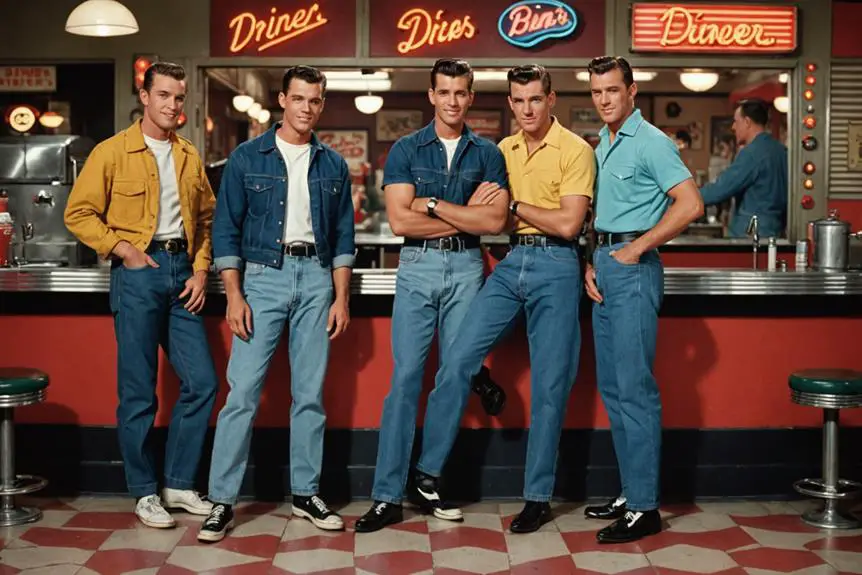
The evolution of denim styles in the 1950s marked a significant turning point in men's fashion, reflecting broader societal changes. During this decade, you'd notice a shift from high-waisted, wide-leg silhouettes to the emergence of slimmer fits, showcasing a change in fashion sensibilities. Classic jeans of this era often featured pleated designs with a sharp center crease, giving you a polished look even in casual settings. Vintage indigo and dark denim became staples, with brands like Levi's, Wrangler, and Lee leading the way. Identifying vintage characteristics can enhance your appreciation of these denim styles as they often incorporated unique design elements and quality craftsmanship.
As you explored the denim jeans pants of the time, you'd find that fabrics such as traditional cotton twill and sanforized denim offered durability and comfort. The high-waist styles provided a structured feel, while the gradual introduction of flat front trousers towards the late 1950s indicated a move toward modern aesthetics. The changing preferences for denim not only mirrored the evolving tastes of men but also their lifestyles, as jeans began to be more than just workwear. They transformed into a symbol of youth culture and rebellion, establishing a legacy that endures in today's fashion landscape.
Iconic Brands of the Era
In the vibrant landscape of 1950s men's fashion, iconic brands emerged as cultural touchstones, shaping the denim narrative of the decade. Levi's stood at the forefront with their legendary 501 XX jeans, characterized by the distinctive Big E label. These jeans became symbols of rebellious youth culture, resonating deeply with the generation's desire for self-expression.
Wrangler quickly carved out a niche with their rugged cowboy jeans, particularly the 11MWZ model, designed for durability and comfort, catering to both working men and rodeo enthusiasts. Meanwhile, Lee introduced the 101 Rider jeans, showcasing high-quality selvedge denim that appealed to both cowboys and fashion-forward consumers.
Penneys Big Mac emerged as a household name, offering affordable work jeans that provided quality without breaking the bank, making denim accessible to the average American. Blue Bell, a division of Wrangler, focused on comfort and style, often incorporating innovative designs like the Talon zipper, making their jeans a favorite among denim enthusiasts.
Each brand contributed uniquely to the 1950s denim landscape, reflecting the era's values of ruggedness, affordability, and style.
Price Points and Value
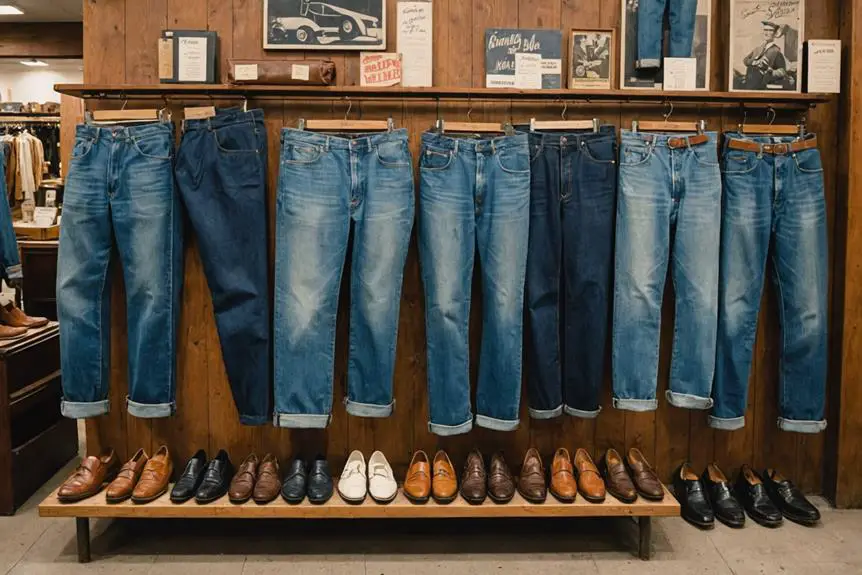
When exploring the price points and value of 1950s men's jeans, you'll find a fascinating range that reflects their historical significance and desirability among collectors. Vintage jeans from this era typically range in price from $49.99 to over $2,000, depending on brand, condition, and rarity. High-value items like vintage Levi's 501 XX can command prices up to $1,250, while other brands, such as Lee Riders, may exceed $2,000.
Jeans featuring selvedge denim or unique designs, like the Vintage 1950s Wrangler Blue Bell Cargo Carpenter jeans, often carry higher prices due to their collector appeal. When considering your purchase, it is important to factor in shipping costs, which can add $5.75 to $40.00 to the final price.
Many listings on platforms like eBay and Etsy provide "or Best Offer" options, allowing you to negotiate prices for sought-after vintage jeans. This can lead to better value, especially for collectors looking to score high-value items without breaking the bank. Understanding these dynamics will help you navigate the market for 1950s jeans effectively, ensuring you make informed purchasing decisions.
Features of 1950s Jeans
Often regarded as iconic, 1950s jeans showcased a distinctive blend of style and function that resonated with the cultural trends of the era. You'd notice that these jeans typically featured high-waisted designs, reaching up to the belly button, which contributed to a flattering silhouette. This feature not only enhanced comfort but also aligned with the decade's fashion sense that emphasized a defined waistline.
The wide-leg fit was another hallmark of 1950s denim. Often paired with rolled cuffs, this design offered a casual yet stylish appearance, perfect for everyday wear. Crafted from durable cotton denim, these jeans provided longevity, while some styles incorporated synthetic blends for added comfort.
Color choices during this time leaned towards medium blue, chocolate brown, and even vibrant pastels like pink and teal, allowing for versatile casual wear. Additionally, unique design elements such as pleated fronts, sharp center creases, and distinctive stitching details emphasized their vintage appeal. Each of these features combined to create jeans that weren't just functional; they were a statement of individuality and style, reflecting the cultural landscape of the 1950s.
Popular Cuts and Fits
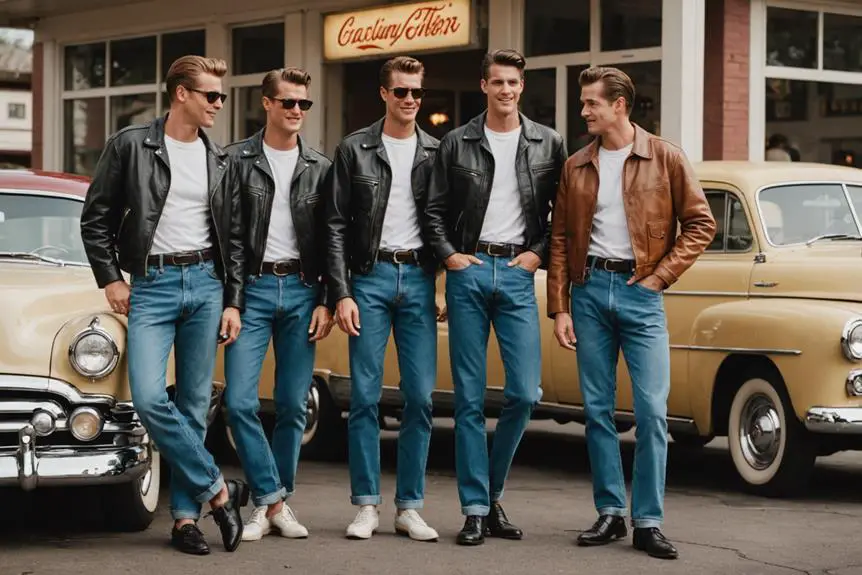
The distinctive features of 1950s jeans naturally led to a variety of popular cuts and fits that defined men's fashion during the decade. High-waisted and wide-leg styles became the hallmark of the era, emphasizing a relaxed silhouette that suited the casual aesthetics of post-war America. These jeans often featured rolled cuffs, enhancing their laid-back appeal. Pleated fronts were also common, striking a balance between comfort and a tailored look, allowing for ease of movement while maintaining a polished appearance.
Brands like Wrangler and Lee played a significant role in popularizing these trends, offering iconic cuts such as the 13MWZ Cowboy Cut, celebrated for its original fit and durability. As the decade progressed, a shift toward slimmer fits emerged, with flat front trousers gaining traction for summer wear. This evolution reflected changing preferences in men's fashion, moving towards more streamlined styles while still embracing the denim fabric that had become a staple. The palette of colors available, ranging from classic medium blue to vibrant pastels, catered to diverse tastes, ensuring that men could express their individuality through their jeans while staying true to the popular cuts of the time.
Cultural Impact of Jeans
Jeans in the 1950s transcended their utilitarian origins to become powerful symbols of rebellion and youth culture. You can trace this cultural impact through iconic figures like James Dean and Marlon Brando, who popularized denim in films that defined a generation. As rock and roll surged, artists like Elvis Presley embraced jeans, further embedding them into the fabric of teenage identity.
The shift of denim from workwear to fashion item sparked a broader social change. By the end of the decade, jeans weren't just for the working class; they became a staple among various subcultures, from beatniks to hippies. Styles such as the Straight Leg and Dark Wash jeans emerged, making them versatile for both casual mens outfits and high fashion. This evolution of jeans made them a canvas for self-expression, illustrating the cultural shift towards individuality and youth empowerment.
- Big E jeans symbolized authenticity.
- Vintage inspired designs started gaining traction.
- Casual mens fashion adopted denim as a norm.
- The versatility of jeans made them essential.
- Denim workwear transformed into a style statement.
The 1950s truly set the stage for jeans to become a timeless fashion staple.
Sizes and Availability
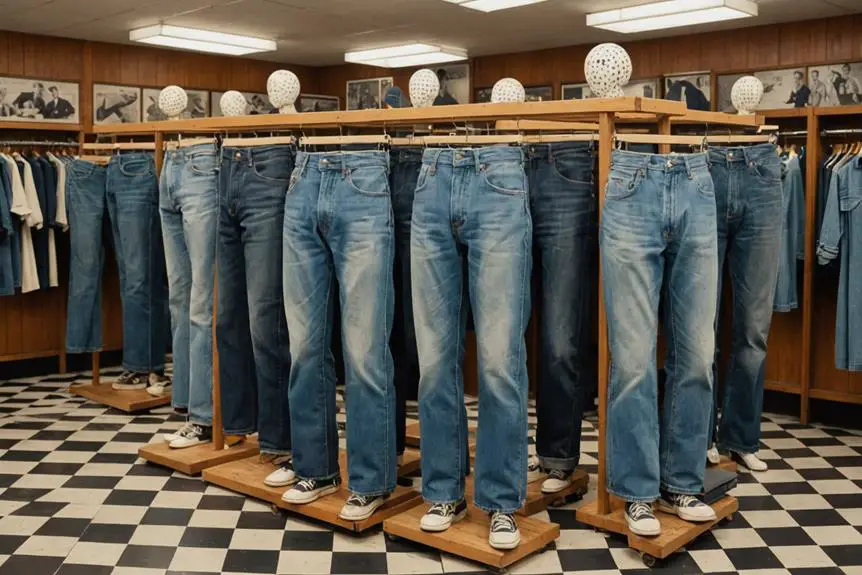
In the domain of vintage fashion, finding the right size in 1950s men's jeans can be both a challenge and an adventure. The sizing system of this era often reflects unique specifications, making it essential for you to navigate the various options carefully. Common sizes like 28×32, 31×33, and 32×28 were prevalent, catering to the high-waisted and wide-leg styles that defined the decade. For instance, Cow Puncher Jeans and Lee Union Made Sanforized jeans illustrate this diversity, with specific listings such as 25×26 and 36×30.
However, you might encounter complications due to unique sizing. Styles such as the Penneys BIG MAC Low Back Overalls present sizes like 32×29, while brands like Toughskins and Circle S jeans may not specify sizes at all, complicating your shopping experience. The demand for authentic fits during the 1950s heavily influenced jeans availability, emphasizing the importance of knowing your measurements. When searching for vintage 1950s jeans, familiarity with these sizing quirks can profoundly enhance your hunt, ensuring you find a pair that fits comfortably and showcases the era's distinctive style.
Collectors' Insights and Trends
Maneuvering through the vintage denim market reveals fascinating insights into collectors' trends and preferences from the 1950s. Many enthusiasts are particularly drawn to Vintage 50s Jeans that showcase unique characteristics, such as selvedge denim, which enhances durability and aesthetic appeal. Items like Dark Indigo and Denim Blue Jeans attract attention, as their rich hues reflect the era's style.
Here are some current trends and insights to reflect on:
- Pricing: Big-E Levis 501 XX can fetch prices over $1,250 due to rarity and condition.
- Demand: 1950s Jc Penney jeans priced at $225 show significant interest, with multiple watchers indicating high demand.
- Investment: Collectors are willing to invest, demonstrated by the Lee Riders 101z listed at $2,000.
- Negotiation: Auctions and "or Best Offer" listings allow collectors to negotiate and potentially snag prized pieces at better prices.
- Origin: Items labeled Made In USA often hold a special allure, adding to their historical significance.
As you explore this niche market, understanding these trends will help you appreciate the value and appeal of these iconic mens jeans.
Frequently Asked Questions
What Jeans Did Men Wear in the 1950s?
In the 1950s, you'd likely see men opting for high-waisted jeans with wide legs. They'd enjoy the comfort of sanforized denim, favoring brands like Levi's and Wrangler, which offered distinct styles reflecting the decade's vibrant fashion.
Did Guys Roll Their Jeans in the 50s?
Yeah, guys rolled their jeans in the '50s to showcase their footwear and project a rebellious image. This trend reflected their casual style and nonconformity, becoming a hallmark of youthful expression during that era.
What Year Did Men Start Wearing Jeans?
Men started wearing jeans in the late 19th century as workwear. By the mid-20th century, their popularity surged, especially among youth, who embraced them as stylish symbols of rebellion against traditional clothing norms.
What Did Men in the 1950S Wear?
In the 1950s, you'd notice men sporting tailored suits, casual button-down shirts, and comfortable sweaters. They often paired these outfits with loafers, embracing a polished yet relaxed style that reflected the era's evolving fashion landscape.


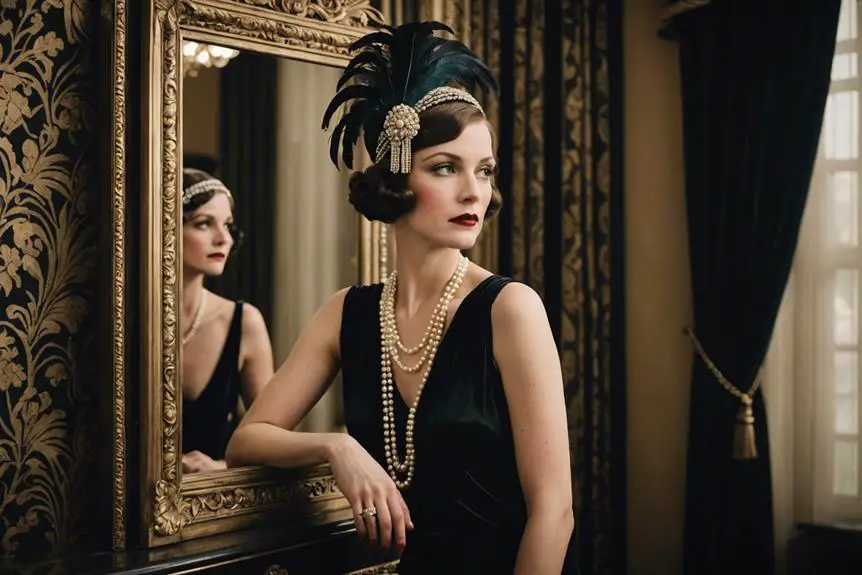

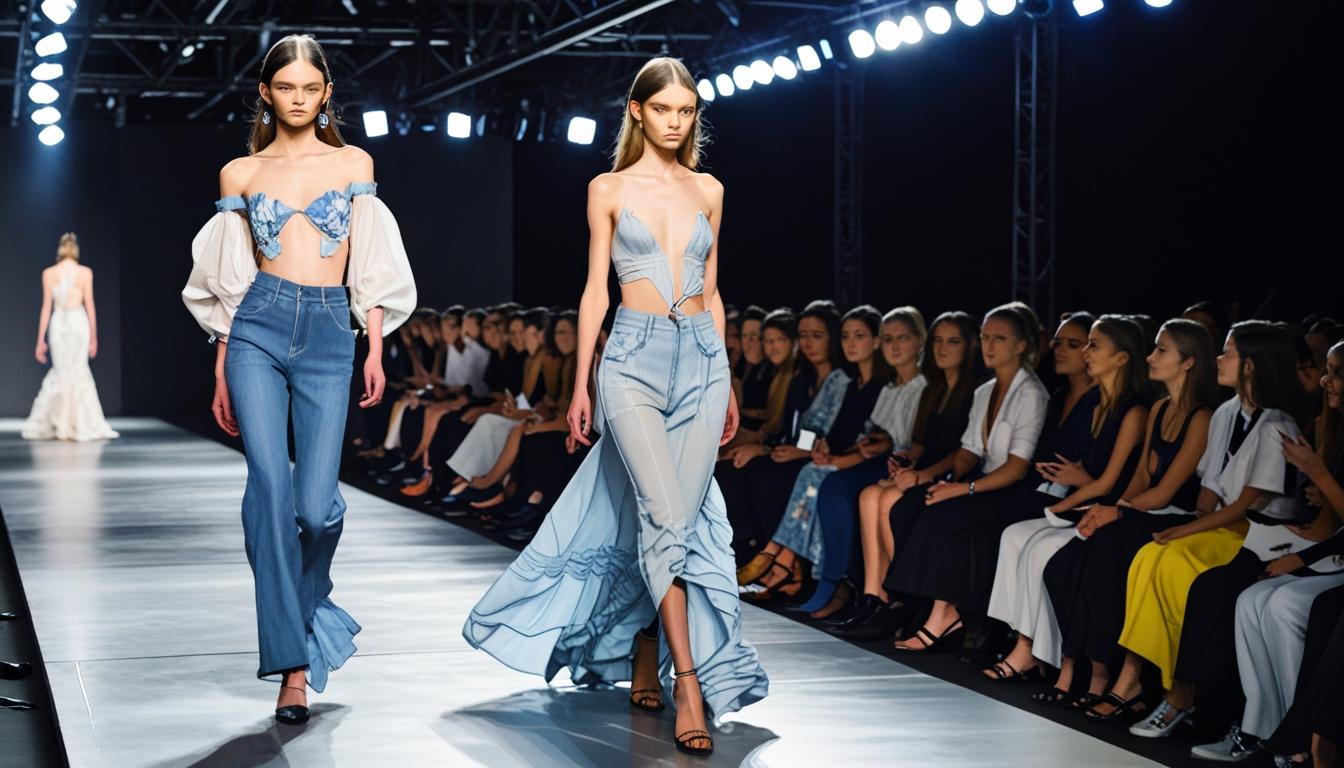
Can you be more specific about the content of your article? After reading it, I still have some doubts. Hope you can help me.
Can you be more specific about the content of your article? After reading it, I still have some doubts. Hope you can help me.
excellent issues altogether, you just gained a emblem new
reader. What could you recommend about your submit that
you just made a few days in the past? Any positive?
whoah this blog is magnificent i love reading your articles. Stay up the good work! You understand, lots of individuals are searching round for this info, you can help them greatly.
Thanks , I’ve just been looking for information approximately this topic for a while and yours is the greatest I’ve found out so far. But, what about the conclusion? Are you certain about the supply?
Howdy this is kinda of off topic but I was wanting to know if blogs use WYSIWYG editors or if you have to manually code with HTML. I’m starting a blog soon but have no coding expertise so I wanted to get guidance from someone with experience. Any help would be greatly appreciated!
I appreciate, cause I found exactly what I was looking for. You have ended my 4 day long hunt! God Bless you man. Have a nice day. Bye
Good post however , I was wanting to know if you could write a litte more on this topic? I’d be very thankful if you could elaborate a little bit more. Thank you!
Hello there! I could have sworn I’ve been to this blog before but after checking through some of the post I realized it’s new to me.Anyways, I’m definitely glad I found it and I’ll be bookmarking and checking back frequently!
This paragraph will assist the internet users for building up new web site or even a blog from start to end.
Hi, Neat post. There is a problem with your site in web explorer, might test this? IE still is the market chief and a large component of other people will leave out your wonderful writing because of this problem.
These are actually great ideas in about blogging. You have touched some pleasant things here. Any way keep up wrinting.
I am sure this article has touched all the internet people, its really really nice post on building up new blog. http://www.kayswell.com
These are actually great ideas in about blogging. You have touched some pleasant things here. Any way keep up wrinting.
I feel this is one of the such a lot important information for me. And i’m satisfied reading your article. But should observation on some normal issues, The site style is perfect, the articles is actually nice :